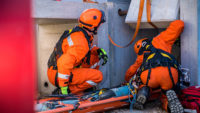Wildfires are one of the world’s natural disasters that have become more common in vulnerable climates. The season length, frequency and surface area of the fires have become more extreme, increasing the danger for the people who fight them.
Here is a discussion of the short and long-term health risks wildfire clean-up crews face and how local and federal governments are working to make their jobs safer.
Short-term health risks
When clean-up crews enter a wildfire burn zone, they’re walking into myriad health risks. Of course, the fire itself is the most immediate threat. Flames on the ground can reach three feet high and hit temperatures over 2000° Fahrenheit. Clean-up crews avoid the largest pockets of fire for their safety, but they feel the adverse health effects in other ways.
Crews spend most of their time navigating burned forests and buildings, where visibility and air quality are not ideal. Additionally, trees or structures affected by the fire can collapse at any moment. They touch and inhale smoke from many hazardous items as they sift through the debris, such as:
- Poisonous plants
- Abandoned vehicles
- Building materials
- Electronic waste
- Plastic
- Cardboard
- Batteries
- Paints
- Pesticides
Crews may be lucky enough to avoid some such items, but it’s impossible to deter the smoke. Vegetative smoke from wildfires contains numerous harmful pollutants the human body doesn’t agree with. These are some of the most dangerous pollutants:
- Carbon monoxide
- Respirable dust (ash, burned soil and heavy metals)
- Crystalline silica
- Polycyclic aromatic hydrocarbons
These substances immediately irritate even the healthiest bodies, causing symptoms like headaches, nausea, fatigue, eye inflammation and respiratory distress. Even worse, anyone on the clean-up crew with chronic heart or lung problems faces a high probability of aggravating their conditions.
To emphasize how many pollutants clean-up crews inhale, studies from the 2018 California wildfire season showed smoke chemicals affected people over 150 miles away from the fire. When a significant wildfire hits California, it’s possible for people in New York City to see smoke trails a few days later.
The effects of wildfire smoke are widespread, but clean-up crews take most of the damage. Smoke surrounds them for days. Even when they’re not on duty, the poor air quality in the nearby region still affects them. In summary, wildfire clean-up crews have grueling jobs with health effects following them everywhere.
Long-term health risks
Research has documented the long-term health effects on wildfire first responders well. No matter how often they work, they still breathe high doses of various pollutants. This exposure leads to massive spikes in lung cancer and heart disease. Lung cancer probability jumps from eight percent to 43%, while heart disease jumps from 16 to 30%.
Many other analyses from 1950 to 2009 reveal similar findings and more. Life expectancy drops, cancer diagnoses rise and sudden cardiac events become disturbingly common.
First responders are also more prone to rhabdomyolysis — or rhabdo for short. This disease is the breakdown of muscle tissue caused by heat exposure and prolonged intense physical exertion. If not treated early, it can lead to kidney failure, permanent disabilities and even death.
Efforts to improve first responders’ health
Based on the debilitating effects of wildfire clean-ups, the current safety protocols and protective equipment are clearly inadequate. Experts in aerospace medicine believe personal air purifiers are the solutions to blocking smoke particles and ensuring respiratory protection.
The same experts also emphasize the importance of first responder hydration, but not for the reason you might think. Drinking reinforces the function of the cilia — the small hair-like cells in your airways that pick up inhaled pollutants. Thus, a hydrated body filters out contaminants more efficiently than a dehydrated one.
Personal purifiers combined with sufficient hydration can make clean-up crews more comfortable in the line of duty, but community efforts are required to reduce the widespread effects of wildfires.
Many communities in vulnerable regions like California have established nonprofit organizations and educational programs. For example, Healthy Fresno Air specializes in local air monitoring and raises local awareness about wildfire safety habits. One such practice gaining popularity is transitioning from hazardous overhead powerlines to safer microgrids to reduce fire risk.
Many vulnerable regions are also looking into ways to reduce wildfire risks in the first place. Replacing vulnerable power lines with energy-efficient remote grids can help reduce the risk of electrocution and power outages.
Government-funded groups such as the National Institute of Environmental Health Sciences have implemented worker training programs to help wildfire clean-up crews. The California Environmental Protection Agency has also changed its policies, having trained teams in HAZMAT suits remove hazardous debris before volunteer clean-up crews arrive.
The EPA, OSHA and other federal organizations have set strict exposure limits for first responders called the National Ambient Air Quality Standards. These standards set a 30-minute exposure limit at one time for life-threatening environments and enforce a maximum 40-hour work week to promote worker safety.
The EPA also donated $7 million in 2021 to help 10 research projects investigate intervention strategies for minimizing exposure and health risks from wildfires.
First responders deserve the best
Wildfire clean-ups will always carry a degree of risk, but first responders' short- and long-term health risks are worse than they need to be. The three keys to safer wildfire response are improved equipment, increased community awareness and more worker-friendly policies.
First responders put their lives on the line every time a disaster strikes, so they deserve the best efforts from their neighbors and government.



